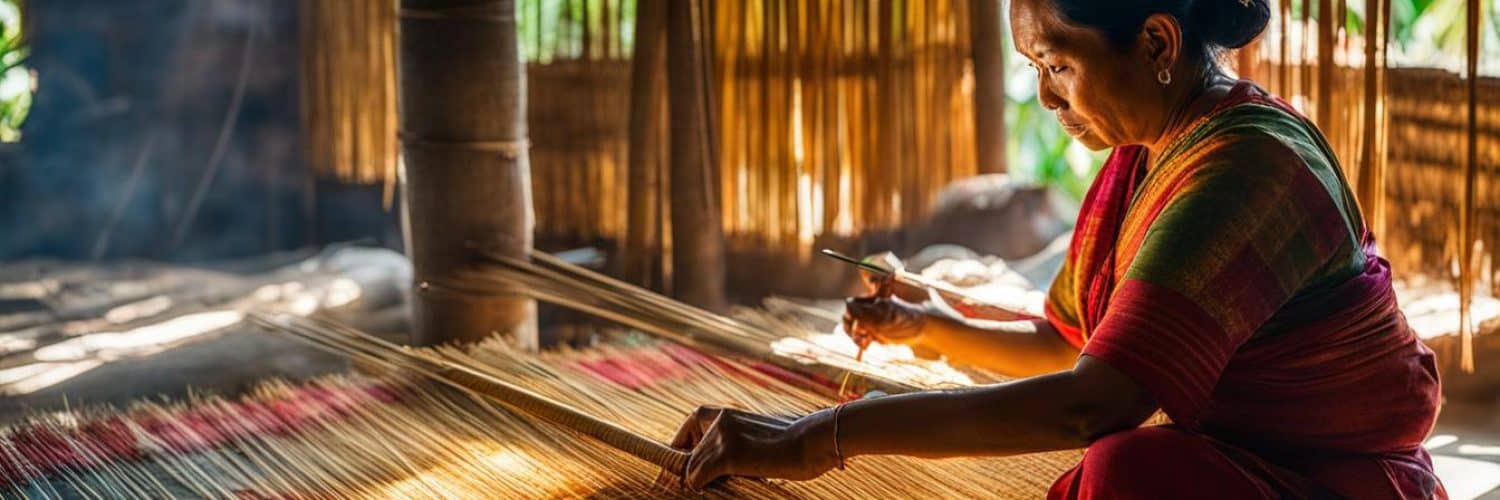Have you ever wondered how the finest handwoven fabrics are created? Or how indigenous crafts have shaped the cultural heritage of a country? Discover the world of Pina weaving in Aklan, a province in Panay, Philippines. This traditional craft showcases the artistry and skill of Filipino weavers, producing luxurious and sustainable textiles that have captivated the fashion industry. But why is this ancient weaving technique at risk of fading away? And how can we play a role in preserving this cultural heritage? Let’s delve into the vibrant world of Pina weaving and unravel the secrets of this exquisite Philippine tradition.
Key Takeaways:
- Pina weaving is a traditional craft in Aklan, Philippines, using the leaves of a wild red pineapple.
- The art of Pina weaving has a long history in the Philippines, showcasing the resourcefulness and ingenuity of Filipino weavers.
- The process of Pina weaving involves leaf extraction, fiber preparation, drying, and intricate weaving techniques.
- Pina fabric is known for its strength, beauty, and significance in Philippine culture, often worn during formal occasions.
- The declining number of weavers and limited market demand pose challenges to the preservation and growth of Pina weaving.
The History of Pina Weaving in the Philippines
Pina weaving has a long and rich history in the Philippines, deeply ingrained in Filipino culture. Its origins can be traced back to the Spanish colonial era when the Wild Red Pineapple was introduced to the country. This unique variety of pineapple provided Filipino weavers with a novel material for their craft, showcasing the resourcefulness and ingenuity of Filipino artisans.
Over the past two centuries, Pina weaving has evolved from a traditional craft to a thriving industry that celebrates the talent and creativity of Filipino weavers. The craft has become an integral part of the Philippine cultural heritage, admired for its exquisite beauty and meticulous craftsmanship.
Throughout the years, Pina weaving has continued to captivate both local and international audiences with its intricate designs and unparalleled quality. It has become a symbol of Filipino artistry and a testament to the resourcefulness of Filipino weavers.
“Pina weaving is not just a craft; it is a testament to the resilience and creativity of the Filipino people.”
Highly regarded for its historical significance and cultural value, Pina weaving represents more than just a traditional craft. It embodies the spirit and identity of the Filipino people, fostering a sense of pride and appreciation for their heritage.
In the next section, we will explore the process of Pina weaving, delving into the intricate techniques and labor-intensive nature of this extraordinary craft.
| Key Highlights | |
|---|---|
| Origin | Spanish colonial era in the Philippines |
| Significance | Integral part of Philippine cultural heritage |
| Evolution | From traditional craft to thriving industry |
| Resourcefulness | Showcases ingenuity of Filipino weavers |
The Process of Pina Weaving
The art of Pina weaving involves a meticulous process that showcases the skill and craftsmanship of Filipino weavers. Let’s explore the intricate steps that transform the leaves of the Wild Red Pineapple into exquisite Pina fabric.
Leaf Extraction and Fiber Preparation
To begin the Pina weaving process, weavers carefully extract the fibers from the leaves of the Wild Red Pineapple, also known as the Pineapple textile fiber (Ananas comosus (L.) Merr.). These leaves are chosen for their optimal quality and strength. The fibers are separated into two types: Bastos and Liniwan. Bastos, the more affordable fiber, is commonly used in everyday wear, while Liniwan, the scarcer and more expensive fiber, is reserved for special occasions and luxury garments.
Drying the Fibers
Next, the fibers are thoroughly washed to remove any impurities and the green color of the pineapple leaves. Once cleaned, the fibers are carefully dried under the warm Filipino sun. This drying process is vital in ensuring that the fibers become strong and elastic, ready for weaving.
Weaving Technique
The dried fibers are then knotted together to create bundles, which are the building blocks for the weaving process. Traditional handlooms, also known as “habulan,” are used by skilled weavers to craft intricate patterns and designs on the fabric. This weaving technique requires precision, patience, and a deep understanding of the artform.
“Pina weaving is a delicate dance between tradition and innovation, where each thread is carefully woven to create a masterpiece that tells a story.”
– Anonymous
The result of this labor-intensive process is the renowned Pina cloth—a fabric known for its strength, beauty, and luxurious texture. Pina fabric has a distinct translucent quality and is highly valued in the world of luxury textiles.
| Step | Description |
|---|---|
| 1 | Extraction of fibers from Wild Red Pineapple leaves |
| 2 | Separation of fibers into Bastos and Liniwan |
| 3 | Cleaning and washing of fibers |
| 4 | Drying of fibers under the sun |
| 5 | Knotting of dried fibers into bundles |
| 6 | Weaving process using traditional handlooms |
Pina weaving is not just a process but an artform that has been passed down through generations, preserving the rich cultural heritage of the Philippines. The dedication, skill, and attention to detail required in Pina weaving make it a testament to the ingenuity and spirit of Filipino artisans.
The Artisans of Pina Weaving
Pina weaving is an exquisite traditional craft that is predominantly practiced by skilled artisans who have inherited their weaving knowledge and skills from previous generations. This ancient craft is deeply rooted in Filipino culture and has been passed down within families for centuries.
Most of the weavers who specialize in Pina weaving are women, as the craft demands a great deal of dedication, patience, and a profound understanding of the intricate techniques involved. They have honed their skills over years of practice, mastering the art of transforming the delicate fibers of the Wild Red Pineapple into elegant Filipino clothing.
However, the number of Pina weavers is steadily declining, with fewer young people showing interest in learning this traditional craft. This poses a significant challenge to the preservation of Pina weaving as a cultural heritage.
Efforts are being made to address this issue and encourage younger generations to appreciate and continue the tradition of Pina weaving. Initiatives such as educational programs and community workshops aim to spark interest and provide opportunities for aspiring weavers to learn from experienced artisans.
Pina weaving is not just a craft; it is a testament to the rich cultural heritage of the Philippines. The preservation of this traditional art form is essential for sustaining the cultural identity of the Filipino people. By supporting and valuing the work of Pina weavers, we ensure the continuity of this remarkable craft and contribute to the cultural preservation of the Philippines.
The Significance of Pina Fabric
Pina fabric, derived from the leaves of the Wild Red Pineapple, holds immense cultural and symbolic value in Philippine tradition. It is the fabric of choice for creating traditional attire, such as the exquisite baro’t saya dresses for women and the distinguished barong tagalog shirts for men.
Adorned with Pina fabric, formal occasions like weddings and cultural celebrations come alive with elegance and sophistication. The lightweight texture and natural sheen of Pina fabric elevate any outfit, making it a timeless choice for those seeking refined attire.
Yet, the significance of Pina fabric extends beyond its aesthetic appeal. Rooted in sustainable textile production, Pina fabric embodies the principles of ethical and eco-friendly fashion. The use of natural fibers and traditional weaving techniques not only ensures the longevity of this cultural heritage, but also contributes to the preservation of our environment.
Pina fabric serves as a symbol of cultural identity, representing the rich tapestry of Philippine tradition and heritage. Its intricate patterns and designs reflect the creativity and artistry of Filipino weavers, underscoring the importance of cultural preservation.
“Pina fabric is more than just a piece of cloth; it is a thread that connects us to our roots and embodies the essence of our cultural identity,” says Maria Cruz, a renowned weaver from Aklan.
| Benefits of Pina Fabric |
|---|
| Enhances the beauty of traditional attire |
| Symbolizes sustainable and ethical fashion |
| Preserves cultural identity and heritage |
| Reflects the artistry of Filipino weavers |
“Pina fabric is not only a testament to our craftsmanship, but also a sustainable embodiment of our cultural identity. Each thread we weave represents our connection to our roots and the preservation of our ancestral traditions.” – Luisa Santos, President of the Philippine Weaving Society
The unmatched quality and exquisite craftsmanship of Pina fabric have garnered recognition and popularity, both locally and internationally. Fashion enthusiasts worldwide have come to appreciate the distinct beauty and timeless appeal of Pina fabric, transcending borders and cultural boundaries.
By celebrating and embracing Pina fabric, we not only support the livelihoods of Filipino weavers but also ensure the continued existence of this remarkable cultural treasure. Let us proudly don Pina fabric, embodying sustainability, cultural identity, and the enduring legacy of Philippine weaving traditions.
The Challenges Faced by Pina Weavers
Pina weaving, a cherished traditional craft, is facing several challenges that threaten its future sustainability. These challenges include a declining number of weavers, a lack of interest among the younger generation in learning the craft, and the limited demand for Pina fabric in a niche market.
One major challenge is the declining number of weavers, particularly among the younger generation. Pina weaving requires significant time, skill, and patience, which may not align with their interests in the modern era. This decline puts the knowledge and techniques of Pina weaving at risk of being lost.
Moreover, the demand for Pina fabric is limited to a niche market. While Pina fabric is highly valued for its beauty and craftsmanship, it caters to a specific clientele. This limited market can make it difficult for weavers to sustain their livelihoods and secure a consistent income.
Efforts are being made to address these challenges and raise awareness about the importance of supporting Pina weaving. By highlighting the cultural significance and contributions of Pina weaving to sustainable textile production, advocacy groups and organizations aim to garner more appreciation and demand for this unique craft.
“Preserving the art of Pina weaving is not only crucial for cultural heritage but also for ensuring the livelihoods of the talented artisans behind this traditional craft.”
An increase in community support, market engagement, and educational initiatives can help revive interest in Pina weaving among the younger generation and create sustainable opportunities for weavers. By recognizing the value and importance of Pina fabric, we can contribute to the preservation of this remarkable cultural heritage and support the livelihoods of skilled artisans.
Challenges Faced by Pina Weavers
| Challenges | Impact |
|---|---|
| Declining number of weavers | Potential loss of knowledge and techniques |
| Lack of interest in learning | Difficulty in passing down the craft to younger generations |
| Niche market | Limited demand for Pina fabric |
| Sustainability | Challenges in sustaining livelihoods for weavers |
Reviving the Pina Weaving Industry
Efforts to revive the Pina weaving industry are underway, aimed at ensuring its long-term survival and promoting cultural preservation. Various initiatives have been implemented by government agencies and community organizations to support weavers and empower them economically. Training programs and workshops are offered to enhance the skills of weavers, while Schools of Living Traditions have been established to pass down the knowledge of Pina weaving to younger generations.
By creating awareness about the cultural importance of Pina weaving and providing educational opportunities, these initiatives contribute to the revitalization of the industry. Community support is also crucial for sustaining the Pina weaving industry. Through market demand and appreciation, the industry can thrive and inspire weavers to continue their craft.
Let’s take a closer look at some of the initiatives:
- Training programs and workshops
- Schools of Living Traditions
“Weaving keeps our culture alive. It is an art that embodies our heritage and traditions. By supporting Pina weaving, we not only support the livelihoods of the weavers but also preserve our cultural identity.”
Community support plays a vital role in the revival of the Pina weaving industry. Recognizing the value of Pina fabric and its cultural significance helps create a market for the handwoven fabrics, ensuring the sustainability of the craft.
The Future of Pina Weaving
The future of Pina weaving depends on the collective efforts of artisans, communities, and consumers. To ensure the continuity of this traditional craft, it is crucial to prioritize cultural heritage preservation. Embracing innovation and exploring new designs and patterns can attract wider audiences and expand the market for Pina fabric. Sustainable growth is key, with a focus on ethical sourcing, fair trade practices, and environmental consciousness. Achieving global recognition and appreciation for the artistry and quality of Pina fabric can further elevate its status and support the livelihoods of weavers. With concerted efforts, Pina weaving can flourish and continue to be a source of pride for the Philippines.
The Impact of Pina Weaving on Local Communities
Pina weaving plays a significant role in the economic empowerment and sustainable development of local communities. This traditional craft provides a source of livelihood for skilled weavers, contributing to the economic growth of rural areas.
The industry creates opportunities for skill development, job creation, and income generation, fostering economic empowerment within the community. Weavers not only earn a sustainable income but also gain valuable expertise in this intricate craft, preserving their cultural heritage while supporting their families.
Furthermore, Pina weaving strengthens community cohesion by serving as a cultural symbol. Weaving communities take immense pride in their craft, as it encapsulates their identity and traditions. The preservation of this craft instills a sense of unity and shared purpose among community members, fostering social bonds and cultural pride.
Moreover, Pina weaving encourages social entrepreneurship among artisans and stakeholders. By collaborating and marketing their products, they create sustainable business ventures that promote local artistry and creativity. The promotion of Pina fabric not only benefits the weavers but also showcases the rich heritage of the Philippines to a global audience.
The positive impact of Pina weaving extends beyond economic benefits. It enriches the social fabric of communities, preserves local traditions, and establishes a foundation for sustainable development. By supporting Pina weaving, individuals contribute to the economic empowerment, community cohesion, and social entrepreneurship that revitalize and preserve the cultural heritage of Pina fabric.
Pina Weaving as a Cultural Treasure
Pina weaving is not just a traditional craft; it is a cultural treasure that holds immense significance in the Philippines. As a part of the intangible cultural heritage of the country, it represents the artistic expression, creativity, and craftsmanship of Filipino weavers. The intricate patterns and designs woven into the fabric reflect the rich cultural heritage of the Philippines, showcasing the diverse traditions and stories of the different regions.
Pina fabric is more than just a piece of cloth; it evokes a sense of national pride and serves as a symbol of Filipino identity. The weavers’ skillful hands transform the pineapple fibers into exquisite textiles that are worn on special occasions, such as weddings and formal events. These garments not only showcase the beauty of Filipino craftsmanship but also embody the cultural values and traditions passed down through generations.
Recognizing and valuing Pina weaving as an important cultural tradition is crucial for preserving and promoting the unique heritage of the Philippines. By supporting and celebrating the art of Pina weaving, we ensure that this intangible cultural heritage continues to thrive and inspire future generations. It is through this cultural treasure that the artistic spirit and national pride of the Filipino people are woven together.
| Cultural Heritage | Intangible Cultural Heritage | Artistic Expression | National Pride |
|---|---|---|---|
| The embodiment of Filipino culture and traditions | A significant part of the intangible cultural heritage of the country | Showcases the artistry and creativity of Filipino weavers | Evoke a sense of national pride and serve as a symbol of Filipino identity |
| Preserves the traditional crafting techniques and knowledge | Represents the living heritage of the Philippines | Expresses the unique cultural stories and identity of the Filipino people | Contributes to a collective sense of national identity and belonging |
| Passes down cultural values and traditions from one generation to another | Embodies the cultural diversity and richness of the Philippines | Provides a platform for artistic innovation and self-expression | Serves as a source of inspiration and pride for the Filipino community |
Supporting the Pina Weaving Industry
Supporting the Pina weaving industry is crucial for the preservation and growth of this traditional craft. By taking various actions, individuals can contribute to sustaining the artistry and cultural significance of Pina fabric.
One way to support the industry is through collaborative efforts between artisans, designers, and fashion brands. These collaborations can result in innovative and unique products that blend traditional craftsmanship with contemporary aesthetics. By bringing together different perspectives and skills, artisan collaborations can breathe new life into Pina weaving, attracting a wider audience and fostering appreciation for the craft.
Moreover, embracing sustainable fashion practices plays a vital role in supporting Pina weavers. By purchasing Pina fabric made with ethically sourced materials, individuals can engage in ethical consumerism and contribute to the demand for sustainable products. Sustainable fashion not only supports the livelihoods of artisans but also promotes environmental consciousness and responsible consumption.
Cultural tourism also presents an opportunity for supporting Pina weavers. Promoting visits to weaving communities allows tourists to experience the art of Pina weaving first-hand, fostering cultural exchange, and creating economic support for local artisans. Cultural tourists can gain a deeper understanding of the craftsmanship involved in Pina weaving and contribute to the preservation of this traditional craft.
By appreciating and investing in Pina weaving, individuals play a significant role in keeping this cultural treasure alive. Whether through artisan collaborations, sustainable fashion choices, or cultural tourism, supporting the Pina weaving industry ensures the continuity of this traditional craft, cultural heritage preservation, and the empowerment of the weaving communities.
Key Takeaways:
- Collaborations between artisans, designers, and fashion brands can create innovative products that blend traditional craftsmanship with contemporary aesthetics.
- Embracing sustainable fashion practices, such as purchasing Pina fabric made with ethically sourced materials, supports ethical consumerism and drives demand for sustainable products.
- Cultural tourism promotes visits to weaving communities, allowing for cultural exchange, economic support, and a deeper appreciation of the art of Pina weaving.
- Supporting the Pina weaving industry ensures the preservation of cultural heritage and empowers weaving communities.
The Global Influence of Pina Weaving
Pina weaving has garnered international recognition and has made a significant impact on the fashion industry. The allure of Pina fabric with its luxurious texture and sustainable production methods has captivated designers and consumers worldwide. This resurgence of traditional crafts, including Pina weaving, aligns perfectly with the global movement towards appreciating heritage and handmade products. Pina fabric has become a medium for cross-cultural exchange, showcasing the exceptional talent and artistry of Filipino weavers to a global audience.
The global influence of Pina weaving goes beyond its aesthetic appeal. It contributes to the preservation and revitalization of traditional crafts, ensuring their continued relevance in today’s contemporary world. The recognition of Pina weaving as a cultural treasure transcends borders, giving it a place on the international stage.
“Pina fabric has become an emblem of traditional craftsmanship and cultural heritage, making it a sought-after material for designers worldwide.” – Fashion industry insider
The fashion industry has embraced Pina fabric for its unmatched quality and unique characteristics. It has been incorporated into high-end designs, runway collections, and even red carpet events. The revival of Pina weaving has spurred a renewed interest in traditional crafts and serves as an inspiration for designers looking for authentic and sustainable materials.
The cross-cultural exchange facilitated by Pina weaving contributes to a rich tapestry of artistic expression, as different cultures and traditions converge. It opens up opportunities for collaboration, cultural understanding, and the appreciation of diverse heritages. The global recognition of Pina weaving creates a sense of pride for Filipino artisans and highlights the importance of preserving and promoting traditional crafts in a rapidly changing world.
The Global Influence of Pina Weaving Table
| Key Points | Impact |
|---|---|
| Pina fabric’s luxurious texture | Has captivated designers and consumers worldwide |
| Recognition of traditional crafts | Contributes to the global movement towards heritage and handmade products |
| Cross-cultural exchange | Showcases the talent and artistry of Filipino weavers to a global audience |
| International recognition | Elevates the status of Pina fabric while preserving traditional crafts |
To sum up, the global influence of Pina weaving extends beyond its artistic and cultural significance. It is a testament to the enduring beauty and craftsmanship of traditional Philippine textiles. With international recognition, Pina weaving continues to inspire and connect cultures, ensuring a vibrant future for traditional crafts and cross-cultural exchange.
Conclusion
Pina weaving is a cultural jewel that represents the rich heritage of the Philippines and the production of sustainable luxury textiles. With its long history and intricate process, this traditional craft showcases the skill and creativity of Filipino artisans. However, the future of Pina weaving relies on the collective efforts of artisans, communities, and consumers to ensure its preservation and promotion.
Supporting the Pina weaving industry is crucial in sustaining this valuable cultural tradition. By embracing Pina fabric, individuals contribute to the growth and sustainability of the craft. The demand for Pina textiles not only supports the livelihoods of weavers but also helps preserve the cultural heritage of the Philippines.
As we appreciate the artistic beauty and cultural significance of Pina fabric, we also recognize its role in sustainable luxury textiles. The use of natural fibers and traditional weaving techniques aligns with ethical and eco-friendly fashion practices. By choosing Pina fabric, we contribute to a more sustainable and responsible future.
Let us support and celebrate the artistry of Pina weaving, ensuring that this cultural treasure continues to shine. By valuing and promoting the beauty of Pina fabric, we play a vital role in preserving the cultural heritage of the Philippines and supporting the growth of sustainable luxury textiles.


















Add comment